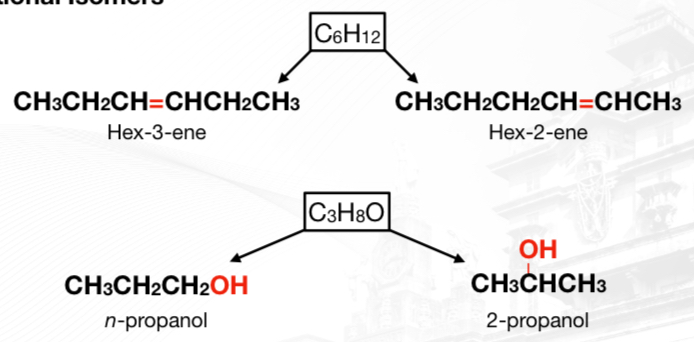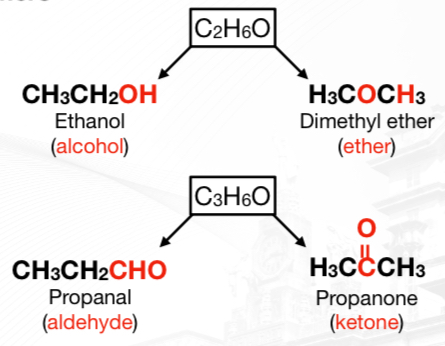Isomers.
1/28
There's no tags or description
Looks like no tags are added yet.
Name | Mastery | Learn | Test | Matching | Spaced |
|---|
No study sessions yet.
29 Terms
Isomers
The same in molecular formula but different in structure
Skeletal Isomers
Isomers with similar formula but different arrangement of carbon atoms.
Positional Isomers
Isomers with similar formula and functional group but at a different position
Functional Isomers
Isomers with similar formula but different functional group.
Skeletal Isomers

Positional Isomers

Functional Isomers

Stereoisomers
Two or more molecules differing only at the spatial arrangement of their atoms
Conformation
Any spatial arrangement atoms may adopt and convert into thru rotation about individual single bonds, e.g. Sawhorse, Newman, and Ring conformations.
Configuration
It is a fixed 3D relationship of atoms in a compound as a results of the bonds between them, e.g. Optical and Geometric configurations.
Conformations
Arrangements that result from the rotation around a single bond.
Sawhorse Conformation

Newman Projection

Ring conformation
Shows the arrangement of carbon molecules in a cyclic / ring form.
Angle strain
Results from the angular deviation of ring structures from the normal 109.5 ℃ angle of each carbon bond.
It results into higher energy and more reactivity of molecules.
Optical Configuration
It is based on the surrounding bonds attached to a chiral carbon.
Enantiomers
Two compounds with same number and kind of atoms and bonds but differ at the spatial arrangement of the atoms and are non-superimposable mirror image of each other.
Diastereomers
Two or more compounds which have different configurations at two or more stereocenters and are not mirror images of each other.
Geometric Configuration
These are two or more compounds which differs from each other in the arrangement of groups in reference to a double bond, ring, or other rigid structure.
Types; cis-tranz isomers, E-Z isomers
cis-trans isomers
Isomers with same connections but differ in the spatial orientation of the group of atoms.
It is used for disubstituted alkenes to illustrate the double-bond geometry of the alkene.
cis
indicates that the groups are attached “on the same side”
Trans
Indicates that the groups are attached “across” each other
Cis-Trans Isomers

E-Z system
Used to illustrate double-bond geometry for alkenes which are trisubstituted or tetrasubstituted.
It makes use of the Cahn-Ingold-Prelog rules to assign priorities to substituents to determine the geometry of the double-bond.
E
“entgegen” meaning “opposite”
Z
“zusammen” meaning “together”
R and S system
Used to illustrate specific configuration of substituents around a chiral center.
It follows the same rules applied to E-Z system.
R
“rectus” = to the right = clockwise
S
“sinister” = to the left = counter=clockwise